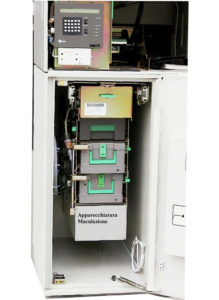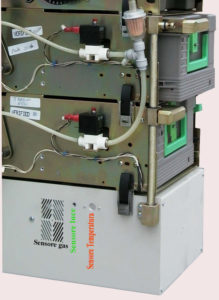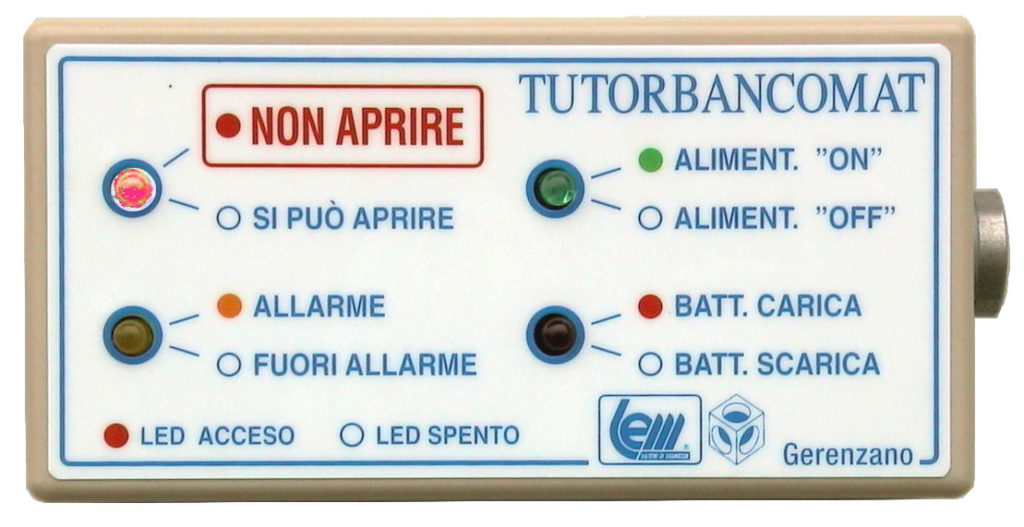The LEM TUTORBANCOMAT EXPG device has been designed to compensate for the continuous evolution of attacks carried out on ATM machines using mechanical, thermal or ram raid means or with explosive gases.
Engineering of the product has made it possible to incorporate both the section that controls banknote staining against physical attacks and ram raids and the section that neutralises attacks which use explosive gases in a single device.
In the design and construction phase, particular attention was paid to ensure false alarms are not triggered. Self-diagnostics of the system will always verify correct operation.
EXPG AntiGas ink staining system
EXPG ANTIGAS INK STAINING SYSTEM
Security
All the active components are enclosed in a box made entirely of high-strength steel. The box itself is installed beneath the banknote cassettes on the dispensing carriage or in the free area around the safe.
This solution resolves significant security-related problems
- It is not possible to neutralise the propellant cylinder by drilling into the equipment box (far enough from the walls of the safe
- It is not possible to perforate the box using an oxyacetylene torch as the flame cannot reach the box and in any case, it is immediately identified by the thermal radiation sensors (light and heat) causing the device to trigger.
- It is possible to perforate the box using a mini thermal lance although the flame is immediately identified by the thermal sensors (light and heat) as soon as it passes the safe walls causing the device to trigger. Even if the attack is carried out by thermal lance experts, much more time would be needed to neutralise the cylinder inside the box compared to the speed of the detection sensors.
Installation/Maintenance
The box equipment is installed beneath the banknote dispenser just like an additional cassette or in an area which can be accessed easily ensuring that it can be removed and refitted quickly and easily for maintenance operations.
There are also a number of advantages such as:
- Automatic engagement of the spray coil when the cassettes are inserted making the operations straightforward for the operator.
- No visible plastic pipe, only a thick steel pipe to prevent cuts.
- The path that the ink has to travel is very short
Can be installed ATMs manufactured by: NCR, Diebold, Wincor, Sigma, Fujitsu
Two examples of an installation:


Ink staining system components
A box containing:
Cylinder containing an AntiGas mixture or inert gas (according to the model) with pressure reading (not technically possible on the AntiGas system).
Explosive attack version: – 1 cylinder containing 2.7 litres of liquid carbon dioxide (each cylinder is accompanied by its test certificate) equipped with a low absorption solenoid valve, to suppress 3 attempts at causing an explosion.
Version with ink staining system only: – 1 x 3 litre cylinder containing gas between 10-11 bar and 0.8 litre of staining ink complete with an opening valve with a pyrotechnic explosive device and signalling pressure gauge. The pressure remains constant as the gas outlet is prevented by the liquid. If there are any micro-leaks in the valve, these would be identified immediately by the presence of the colouring agent.
- Tank in stainless steed (anti-explosive version containing staining ink – 0.4 litres / cassette. The ink is of the high penetration NON TOXIC type. The safety data sheet and laboratory safety policy are available upon request.
- An airtight rechargeable battery ensuring 48-hours of operation in the event of a mains power shortage
- Tilt sensor to check the correct position of the ATM. These intervene triggering the staining system if the ATM is tilted by more than 15 degrees or if there is a brusque movement (tilt effect) in the event of a ram raid – anti-ram raid.
- An electronic circuit board with microprocessor with programmable functions
The circuit board is fitted with:
- Electronic temperature sensor for instantaneous detection of a rapid change in the “delta temperature”; it detects any sudden change in temperature, whether rising (hot) and falling (freezing). If this condition occurs, the device will intervene.
- Two temperature sensors calibrated to 65/70 degrees with an intervention time of approx. 2 seconds
- Two thermal radiation sensors – Innovation to immediately detect attacks using an oxyacetylene torch, mini lance or drilling. The sensors trigger as soon as the external shell of the ATM is perforated in any point.
- Exploding gas sensor with wide spectrum and high sensitivity with digital management algorithm. Automatically compensates for small or slow changes in impurities present in the atmosphere. Prevents false alarms.
- RS 232 serial interface for remote management and programming
- Two auxiliary inputs for an “Immediate alarm” from the external sensors
- 4 open/close contact relays to be used for local and remote alarms (siren, flashing light, Silent alarm telephone auto-dialler etc.). One relay is used for signalling faults, one for signalling that the device has been activated, one for switching off the ATM and a fourth for blocking the opening of the ATM when the stainer is activated
- Opening block contact. This prevents the doors from being opened when the device is active and can be interfaced with Lem electronic locks or locks produced by other manufacturers
On the outside of the box there is:
- Magnetic sensor (tamper) with three reeds to detect the opening of the door
- Thermal sensor fitted inside the door close to a lock
- Power unit with an integrated ATM shutdown system if the ink staining system triggers
- Closing sensors to detect the status of the locks
- Control console located outside the ATM, with 4 warning LEDs indicating the status of the equipment and a sensor for the electronic Secur Key

The console indicates the “status” of the ink staining system as follows:
Sensor for electronic “Secur Key” for authorised access
The electronic “Secur Key” manages the smart disabling of the device (indicated by the designated LED)
Disabling remains “active” for a programmable time – stand-by time – (time between the key being placed on the sensor and the possibility of opening the door)
Since the electronic key is unique, there is a log of the disabling period which can be checked.
If the key is lost, it can simply be cancelled.
The system is automatically re-enabled after it has been disabled, either after the stand-by time or when the door is closed again.
Each device is equipped with a label and a decal showing that the ATM is fitted with the device.
Optionals:
- Hal 600 electronic lock (ICIM Certified) with antitheft/antirobbery functions to interface with the Tutor equipment. In this case false interventions caused by “operator error” will be avoided COMPLETELY. (Technical specifications upon request)
- Duo 4000 electronic lock – contact Lem for the technical specifications
Ink staining system function
The main management parameters are:
- Time bands. Programmable times during which the ink staining system is activated or deactivated
- Daily enabling: it is possible to select days on which the ink staining system cannot be deactivated (typically Saturdays and Sundays)
- Clock/calendar with automatic time adjustments (legal/solar time)
- Automatic management of recognised public holidays with activation of the device 24h/24h
- Cyclical recording of 250 events – Alarms, Door opened,
Enable/disable etc with day, date, time, minutes and seconds. - Authorised access with “Secure Key” (for example, of a management philosophy) Means that the ATM can be opened: In the permitted time band with normal opening of the locks, and with the “Secur Key” in non-permitted time bands together with normal opening. If the door is opened in the non-permitted time band even with the correct key and combination, the device will trigger. This function is extremely important for night time protection ad for remote installations. Even for counterfeits of the authorised key and opening combination in the non-permitted time band, it is not possible to open the door without the device triggering.
Remote management with RS 232 serial port – Local or remote access with a modem
Remote management can be carried out by connecting the RS 232 serial port of the AntiGas/ink staining system to a serial port of the PC. Using a modem connection is it possible to manage the AntiGas/ink staining system from a control room.
The following functions can be controlled:
- Deactivation of the device for emergency opening after having entered a password
- Calibration of the gas sensors (wide spectrum and methane)
- System check and self-diagnostics – battery, external power source, clock, memory parameters
- Clock-calendar setting
- Setting of the time band, national and local public holidays – activated/deactivated
- Authorised access mode selection
- “Stand-by time” setting
- Request saved events
- Device status – Activated/Deactivated, in alarm condition
- Status of the safe doors
- Lock status – Open/Closed
- Disabling – activation
- Alarm status – tilt alarm, gas alarm, light alarm, temperature alarm (for both rapid increase and rapid decrease), thermal sensor alarm
- Remote triggering of ink staining system
- Reset alarms
Two different configurations can be installed:
TUTOR: “EX-MC/G”
Anti-explosive Function + Banknote staining – In the event of an attack it counteracts the explosion of the ATM with gas and simultaneous staining of the banknotes
TUTOR: “MC/G”
Banknote staining function with gas sensor – In the event of an attack it does not counteract the explosion of the ATM but in the event of an attack with gas it will stain the banknotes
The TUTOR BANCOMAT EXPG device has been tested at the CESI Institute of Milan.
Improved functions of the “Tutor” AntiGas/ink staining system
Introduction:
The “ATM tutor” is a device which protects ATMs and safes against attacks using explosive gases to open the safe, based on the principle of lowering the percentage of oxygen in the safe to be protected through the introduction carbon dioxide.
In fact, if the percentage of oxygen is less than 12%, the explosion will not trigger regardless of the amount or type of gas introduced.
However recently, criminals who normally used only propane or acetylene gas have refined their attacking strategies.
In the most recent cases studied, it has been noted that acetylene gas has been used with oxygen (oxyacetylene torch cylinder kit). This new technique means that the effectiveness of the protection provided by the “Tutor” against explosion of safes has been significantly reduced.
Improvements and modifications
These types of techniques have been tested and analysed to counteract the new types of attacks with gas and oxygen:
- A new electronic circuit board has been designed for optimal management of the “Tutor”.
The new system for counteract the attack with the gas works as follows:
When the gas detector enters an alarm condition, carbon dioxide is introduced for a set time based on the volume of the safe and saturates the internal volume thereby lowering the amount of oxygen present. Times for the introduction of carbon dioxide have been optimised. - To increase the effectiveness over time, a special function has been added to the open and close relay of the solenoid valve which introduces carbon dioxide into the safe.
- For further effectiveness as a deterrent, the system can be integrated with a 120 decibel siren whose absorption is compatible with the printed circuit board and activates as soon as the gas alarm is triggered or the banknote dispensing shutter assembly is forced. It must be provided with a sensor. (Optional)
- For ATMs with relatively large empty spaces inside the safe, inflatable plastic containers (Airbags) can be installed, which reduces the internal volume of the safe, greatly improving the neutralising effectiveness of carbon dioxide. (Optional)
- The circuit board has been integrated further with sensors equivalent to the “seismic/selective” sensors which are generally installed on ATMs with the following functions
- Microphone which detects noises due to attacks with all mechanical means
- Accelerometer which detects attacks with mechanical means, thermal lance and shock for ram raids.
- Magnetic sensor for checking opening of the doors (Optional)
This additional avoids the need to install the door control and “seismic/selective” sensors.
With a single connection to the alarm control unit, attacks on the ATM as well as operation of the Tutor are monitored, thereby obtaining significant savings.
Shutter
Sensitization of the ATM Shutter is recommended as it operates when cash is legitimately withdrawn, by an alarm or the triggering of the ink staining system if forced.
The device indicated above is an “open” system allowing it to be updated to accommodate future improvements.